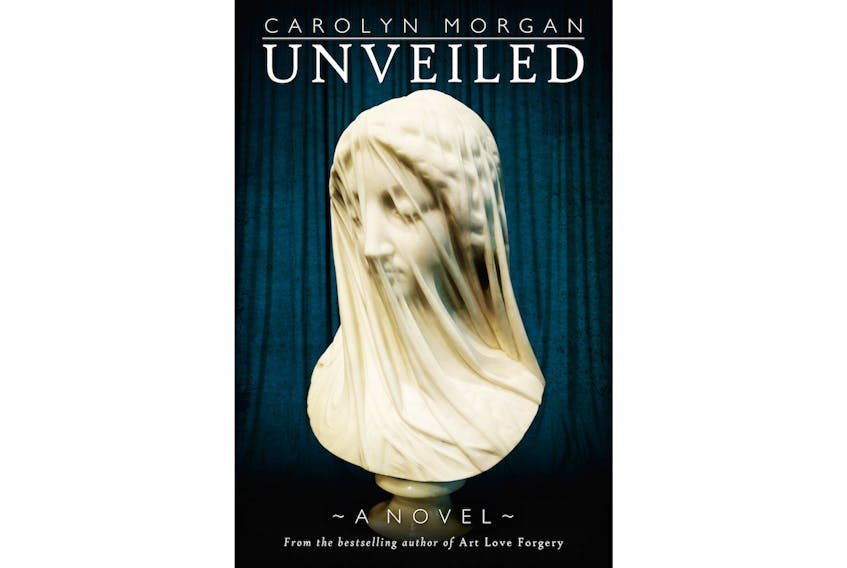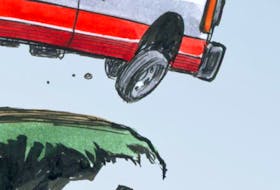At the Presentation Convent in St. John’s, N.L., the Presentation Sisters guard and protect sculptor Giovanni Strazza’s masterpiece the Veiled Virgin.
The sculpture arrived in Newfoundland in 1856 thanks to Bishop John Thomas Mullock who acquired the bust in Rome and shipped it to St. John’s. Although Strazz’s signature appears on the sculpture, little else is known about it. There is no paper trail, so to speak. For more than 150 years, not a soul has known the facts regarding the Veiled Virgin’s history.
Until now.
B’ys, Carolyn Morgan has revealed all in her novel Unveiled (Flanker Press).
How is it possible that Ms. Morgan presently has all the answers, has the detailed provenance of Giovanni Strazza’s remarkable sculpture? The answer might satisfy folks who ask writers this question: “Where do you come up with your ideas?”
Everything came to Ms. Morgan in a dream, l ‘low. And she wrote it down in a storybook.
A viewing of the Veiled Virgin at the Presentation Convent inspires Rebecca Howell to return to Italy for her doctoral degree with the intention of discovering why Stazza sent his masterpiece to Newfoundland.
So, Rebecca’s off to Italy — to Rome, Milan, Florence; to the Chianti Region of Italy and the Lucciola Winery where … well, it’s a winery after all.
Mayhap we readers indulge in a mug of grape juice while we follow Rebecca’s search for the truth (I’m not even going to attempt a lame witticism about in vino veritas) because quicker than Granny caught the weasel, we are in 1855, in Giovanni Strazz’a studio in Rome where Strazza is introduced to Rosa Bouchard, his apprentice’s new art student. After brief chit-chat, Strazza picks up his chisel, his hands a-‘tingle “with the need to carve her (Rosa) in marble.”
At which point, we attentive readers go, “Ah-ha!”
Proper thing.
As I’ve said, Rebecca’s quest takes her to Milan where she meets Luca Rossi and within two pages, in vino readers again go, “Ah-ha!”
Why?
Because — and I confess to fancying a movie adaptation of this scene — during the meeting bursts of animated hearts appear in the air and the author gives us this line: “Later, chewing on her pizza, Rose thought about Luca Rossi. When he smiled, he looked young — 35, maybe.”
Ah-ha for sure, eh b’ys?
Speaking strictly for myself (more knowledgeable readers prob’ly won’t experience the same problem), it took me days to finish this gem-dandy romantic tale.
At least once in every chapter, for instance, I had to dog-ear a page while I darted over to Mr. Google’s house to check out images of one or another of the famous sights peppering the setting. I did have a dim picture of the Trevi Fountain to build on in my noggin, but only blank spaces to fill with images of The Uffizi and the Vasari Corridor.
I had to google images of plants, for frig sake. I’d never heard tell of a stephanotis, a wee white flower likely named after some guy Steve.
I was familiar with Botticelli’s Birth of Venus, not only because I have skimmed through history books, but also because of the cover art on a collection of Kilgore Trout stories (1975) called Venus on the Half-Shell. However, one of Rebecca’s comments caused me to closely examine Venus’ tootsies on my iPad.
Regarding Venus’ feet Rebecca says, “They were quite ugly — large, with a bulging instep.”
Personally acquainted with bulging insteps, I stretched the iPad’s screen and enlarged Venus’ feet. There is a bit of a hump on her left foot.
And, b’ys, believe it or not, except for modestly draped tresses, Venus is stark naked on her scallop shell. Not the tack on!
After concentrated inspection of Venus’ feet my appreciation of Botticelli’s art increased. I moved on to her dainty ankles, her slender shins, her crinkled kneecaps, and points north. Considering my fascination, it was ages before I returned to Rebecca Howell and her efforts to solve the mystery of the Veiled Virgin’s presence in Newfoundland.
There’s a Romeo and Juliet element woven into the mystery. There’s religious conflict. There’s an almost unbelievable family connection between events in 1855 Rome and clues Rebecca uncovers.
Here’s a hint: Giovanni Strazz’s apprentice, who is the reason Rosa Bouchard is in Rome, is called Mario Rossi.
Mario Rossi. Luca Rossi.
Ah-ha!
Listen, Carolyn Morgan has spun an entertaining, quality yarn with a plausible explanation — at least within the realm of fiction — for Strazz’s Veiled Virgin ending up on display at the Presentation Convent in St. John’s.
And you know what else?
I don’t care if the particulars came to Ms. Morgan in a dream. I believe every word of it.
Thank you for reading.
Harold Walters lives in Dunville, Newfoundland, doing his damnedest to live Happily Ever After. Reach him at [email protected].









